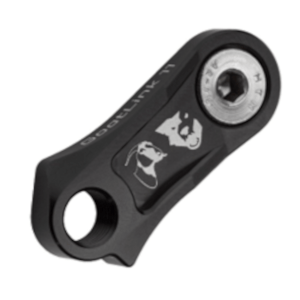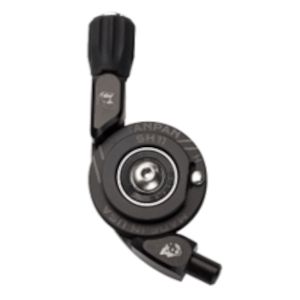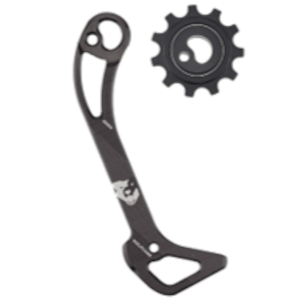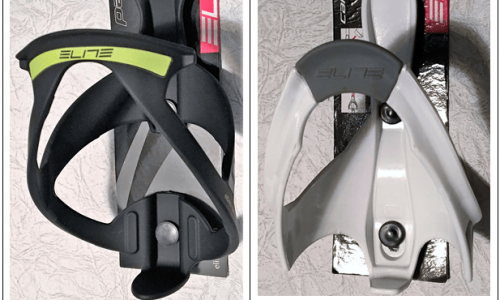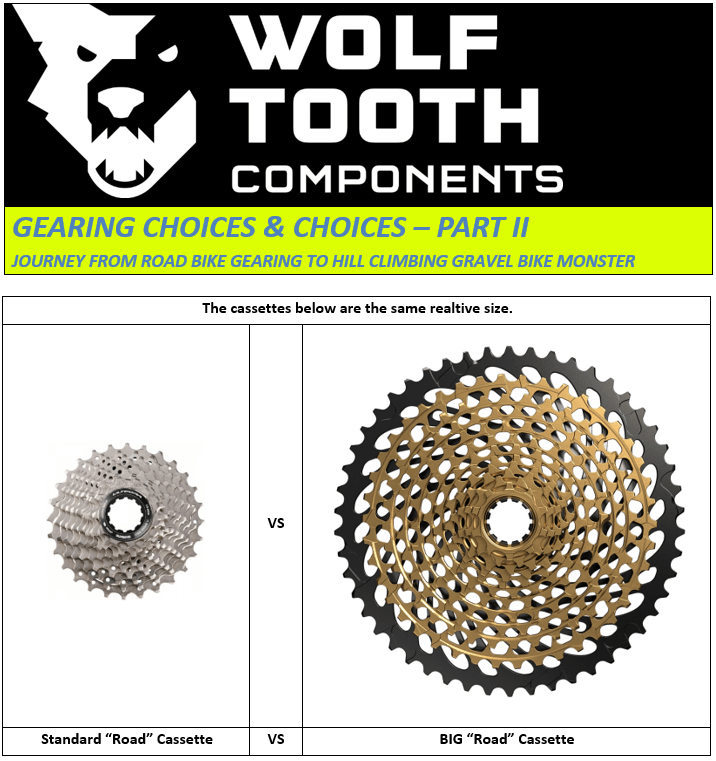
WOLFTOOTH Extended Gearing for the Road Bike
In Part I, we discussed bigger gearing, why use it and how to achieve it. We also discussed the derailleurs total (or maximum) capacity. For those that haven’t read the article, please click here first before reading this one.
After publishing the article, I had quite a few emails that said either “Great job, I had been wanting to do this but thought my only option was a triple [3-chainrings in front]” or, I have a question revolving around capacity.
So, I went back to the drawing board and mapped out several more gear combinations and my first thought was “Maybe Gerard Vroomen is onto something”. That something is 1X for road bikes…in other words, no front derailleur. In fact, for 2018, the Aqua Blue Professional Cycling Team will be riding this 1×12 bike on the World Pro Tour.
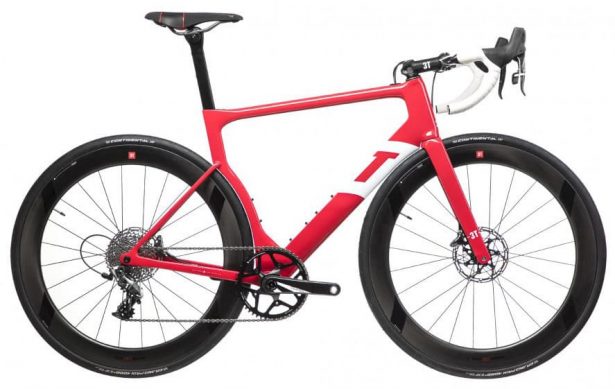
What? 1×12? On the World Pro Tour? But really, is this so farfetched? Gerard mentioned that the pros are either doing mountain stages or flatter sprint stages. On mountain stages they are either inthe small chainring or big chainring using a big cassette gear.
On sprinting stages, they are in the big ring. So, with a 1×12, all you need to do is change out the cassette to match a normal 2×11 for either a mountain or a sprint stage.
But Does This Actually Work?
So, I went back to Excel. Since part 1, I replaced the 52 with a 50. I went completely back to a compact crank setup. This is because I really wasn’t using the 52T much. I climb with the 34T and coasting down the hills, I rarely pedal.
Coasting down a 1.75-mile-long (2.8 km) 14% grade hill, I’m already doing 50 mph (80.5 kph) … don’t see much need to pedal.
But, here is the problem I discovered. Even though it shifts better at the ‘extremes’, there are A LOT of gear duplications.
One would assume that with a standard 2×11 road setup, one would have 22 gears. Well, really 20 if you don’t count the small-small and big-big cross-chained combinations. In reality, my ’22-speed’ 50/34 setup only has 15 usable gears!
Looking at TABLE 1 above, there are 2 sets of data fields. The left set of data includes my current 11-36 cassette with current 50/34 crankset (I included a 52 for comparison). Looking at the field on the left, I noticed some very similar numbers.
I then created the data field on the right by sliding the left column down 3 positions and noticed 6 gear duplications. For example, a 50/25 is EXACTLY the same as a 34/17. Both are 52.90 gear inches (GI). I would actually be better off by putting the 52 back on again!
Which Cassette To Choose?
Looking at TABLE 2, I did an Internet search for mountain bike cassettes. The two companies that came up in the search results were SRAM and SHIMANO. Researching large and viable cassettes (i.e., ones that will fit on a standard road cassette body), I found only 3 possibilities.
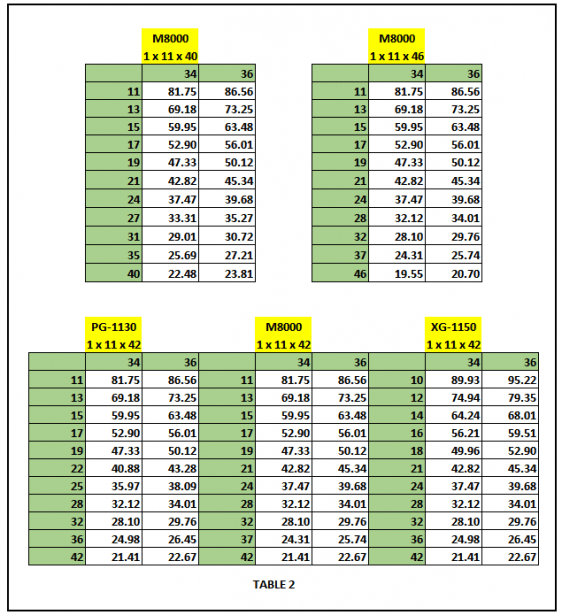
- Shimano M8000
a. 11×40
b. 11×42
c. 11×46 - SRAM PG-1130
a. 11×42 - SRAM XG-1150
a. 10×42
Within these search results, I created TABLE 2, pictured to right. I spoke to several certified mechanics as well as Wolf Tooth, they all said that since I will be running this on a Shimano drivetrain, to rule out cassettes with a 10T cog. That rules out the XG-1150.
They also that since I wanted to go big, I might as well go with the 11-42 vs the 11-40. Or maybe even the 11-46, but this one might be a little much for the RD-6800-GS. So, depending on the front chainring, here are the 3 options.
- SRAM PG-1130 11×42
- Shimano M8000 11×42
- Shimano M8000 11×46
So, which one is best?
Further Analysis
Comparing the PG-1130 vs M8000
Next, I created TABLE 3 (pictured below). TABLE 3 includes the 3 cassettes listed above and,
a) after many discussions with several experts in the field, they recommended the M8000 over the PG-1130 when running on a Shimano drivetrain.
b) shows the Teeth Difference (beige colored column) between each gear of each cassette.
c) shows the GI for each cassette for both a 34 as well as a 36 1x chainring. This will be extremely useful when diving deeper into the analysis (TABLE 4).
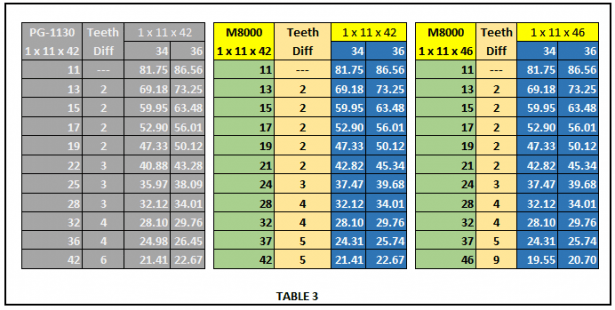
Remember, my current gearing is 50/34, 11-36 and is pictured below (TABLE 3-A). Disregarding the 50T chainring column, my GI range from 24.98 to 81.75 (Note: really 74.94 GI since 81.75 represents a cross-chained condition, but, with a 1x, there is no cross-chaining since there is no second chainring to interfere with a small-small combination, so all 11 gears can be used).
 To determine how much, if any, gain there would be using a 42 vs a 46, for both 34 and 36 chainrings, I created TABLE 3-B.
To determine how much, if any, gain there would be using a 42 vs a 46, for both 34 and 36 chainrings, I created TABLE 3-B.
Here’s how to read this table. With my current 34×11-36 (top row in yellow), I have a GI range from 81.75 to 24.98. Next, with a proposed 34×11-42 (first row in blue), I have a GI range from 81.75 (equivalent to a 50/16) to 21.41, which, when compared to my current 24.98, that’s a 16.67% lower gear. Comparing the 11-42 and the 11-46 to the 11-36, the biggest differences are with the 11-46 (last 2 rows in green).
Feel any difference? – Table 3-C
Without testing these gear combinations, my ‘analytical’ thoughts are as follows.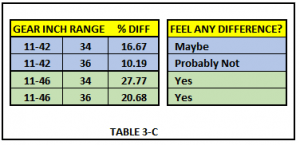
The bottom line is “Will I actually gain more gearing?”.
Going forward, I will do more research and reach out to more people that would know. Going forward, I will probably need to try all combinations.
Equipment Options, Or Research, Research And More Research
One point that was brought out by several mechanics and Wolf Tooth was that the road vs MTB rear derailleurs have different cable pull. In other words, you can’t just bolt a RD-M8000 onto a drivetrain using 6800 shifters.
That being said, what is needed to make this work? The table below shows 2 “bolt-ons” from Wolf Tooth to make this work.

Comparing 1X11 (or 1X12) to 2X11
Next, I wondered what gears I might be giving up. Are these gears I would normally use or gears I wouldn’t use much? TABLE 4 includes my analysis. Two M8000 cassette options 11-42 and 11-46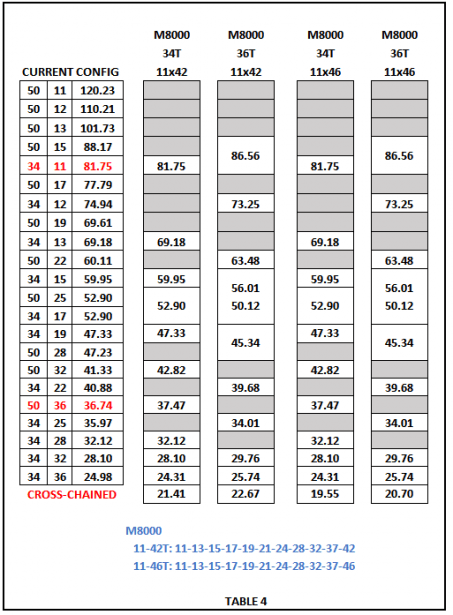 as well as 34T and 36T front chainrings are included.
as well as 34T and 36T front chainrings are included.
The left side of the table shows my current 50/34 & 11-36 configuration in biggest gear-inch (shown first at the top) to smallest gear-inch (shown last at the bottom). The right side of the table shows either a gray box (no gear-inch equivalent) or a number showing gear-inch equivalent.
The table is meant to be read left to right. For example, let’s look at the 4th row of my current configuration values; 50 (chainring), 15 (cassette), which equals 88.17 gear inches.
Reading across to the next 4 columns shows:
a) 34T 11×42 = no equivalent gear
b) 36T 11×42 = equivalent
c) 34T 11×46 = no equivalent gear
d) 36T 11×46 = equivalent
After speaking with some drivetrain experts, I have decided to initially rule out the 11-40 as well as the 10-42. For the 11-40, since I’m already getting a new cassette, I might as well get a couple more teeth (11-42) for the same price.
As for the 10-42, they mentioned that this combination doesn’t shift as well as the 11-42 on a RD-6800-GS rear derailleur, so both the 10-42 and 11-40 are currently out of the running.
SIMPLIFY CHOICES: To simplify this initial research, I have chosen the M8000 cassette – see TABLE 4. So, that’s one less decision to make……
Summary
Going forward, Part 3 will discuss the actual parts chosen as well as the why’s and how-to’s.
Wolf Tooth will be sending their recommend parts and installation notes which I will also share in Part 3.
Until then, I have included some information on the advantages and disadvantages of running a 1X.
Pros
- No gear duplications. What you see is what you get. A 1×11 has 11 usable gears, a 1×12 has 12.
- No cross chaining. All gears are usable.
- No front derailleur required. This simplifies the drivetrain and reduces weight and complexity.
- Can use existing road 11-speed crankset. In my case, the Ultegra 6800.
- Easy to change gearing by just changing cassettes (or chainring).
- With the WolfTooth RoadLink, can use an existing Shimano road (GS) rear derailleur.
Cons
- If you have chosen the right 2X11 cassette, you will have more (non-duplicated) gears than a 1X11 or 1X12.
- For those with a short-caged rear derailleur, you will need to purchase either a long-cage Shimano GS-type or SGS Mountain rear derailleur. For the SGS, you will need to also order the Tanpan from Wolf Tooth.
- You might need to use a rear derailleur extender such as the WolfTooth RoadLink or GoatLink.
Continue with Part 3
[PART 3] EXTENDED GEARING FOR THE ROAD BIKE

I have always enjoyed bicycling and, through a series of coincidences, became a Bicycle Industry Consultant and Product Tester. I test prototype products for companies and have published only off the shelf production products on biketestreviews.com.

